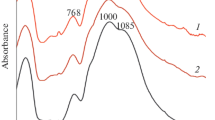Abstract
Glasses based on gallium and indium trifluorides are investigated by IR and19F NMR spectroscopy. An analysis of the IR data showed that the octahedral complexes [GaF6]3− and [InF6]3− are the main structural units of these glasses; the nets of indium and gallium glasses differ in the order of binding between the glassforming complexes. An analysis of NMR data also revealed considerable differences in the structure of these glasses as judged by the effect of the type of alkaline cation on the state of the fluoride subsystem. The gallium net is a threedimensional net consisting of octahedral complexes linked by three edges (uniform conjunction); the indium net has a nonuniform conjunction — by two edges and two vertices.
Similar content being viewed by others
References
J. Lucas,J. Mat. Sci.,24, 1–13 (1989).
I. Náray-Szabo,Kristálykémia, Akadémiai Kiadó, Budapest (1969).
A. Felz,Amorphous and Glassy Inorganic Solids [Russian translation], Mir, Moscow (1986).
S. V. Volkov, V. F. Grishchenko, and Yu. K. Delimarskii,Coordination Chemistry of Salt Melts [in Russian], Naukova Dumka, Kiev (1977).
J. M. Ziman,Models of Disorder, Cambridge University, Cambridge (1979).
S. G. Bakhvalov, E. M. Petrova, and V. V. Valkov,17th International Congress on Glass, Vol. 2, Beijing, China (1995), pp. 473–479.
S. G. Bakhvalov, E. M. Petrova, V. V. Valkov, and V. M. Buznik,Zh. Neorg. Khim.,42, No. 10, 1636–1641 (1997).
S. G. Bakhvalov, E. M. Petrova, V. M. Denisov, and V. M. Buznik,Fiz. Khim. Stek.,23, No. 4, 449–454 (1997).
L. N. Ignatieva, T. F. Antokhina, V. Ya. Kavun, et al.,ibid.,21, No. 1, 75–80 (1995).
V. K. Krasnov (ed.),Molecular Constants of Inorganic Compounds. Handbook [in Russian], Khimiya, Leningrad (1979).
R. M. Almeida and J. D. Mackenzie,J. Chem. Phys.,74, No. 11, 5954 (1981).
R. M. Almeida and J. D. Mackenzie,ibid.,78, No. 11, 6502 (1983).
P. J. Bray, D. E. Hinterlang, L. V. Mulkern, et al.,J. Non-Cryst. Sol.,56, Nos. 1–3, 27–32 (1983).
V. M. Buznik, V. Ya. Kavun, S. G. Bakhvalov, and E. M. Petrova, “Structural studies of the glasses of heavy metal fluorides. II. NMR spectroscopy of topologically disordered glasses”, [in Russian], preprint No. 719F, Institute of Physics, Krasnoyarsk (1992).
J. Wo and É. I. Fedin,Fiz. Tverd. Tela,4, No. 8, 2233–2237 (1962).
V. Ya. Kavun, V. K. Goncharuk, E. B. Merkulov, et al.,Fiz. Khim. Stek.,20, No. 2, 221–226 (1994).
Author information
Authors and Affiliations
Additional information
Translated fromZhurnal Strukturnoi Khimii, Vol. 39, No. 5, pp. 798–807, September–October, 1998.
This work was supported by Krasnoyarsk Regional Science Fund grant No. 6F0206-D.
Rights and permissions
About this article
Cite this article
Bakhvalov, S.G., Petrova, E.M., Livshits, A.I. et al. IR and NMR studies of the structure of glasses based on gallium and indium trifluorides. J Struct Chem 39, 651–659 (1998). https://doi.org/10.1007/BF02903538
Received:
Issue Date:
DOI: https://doi.org/10.1007/BF02903538




